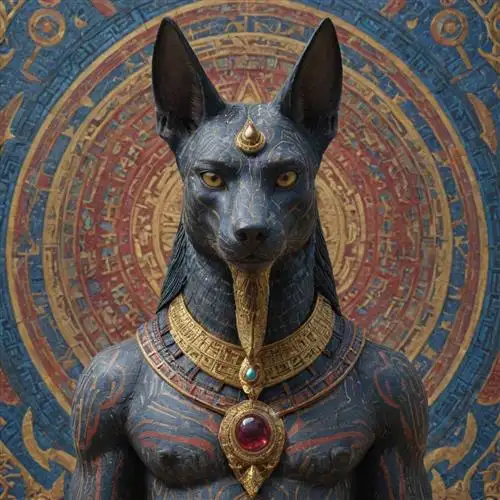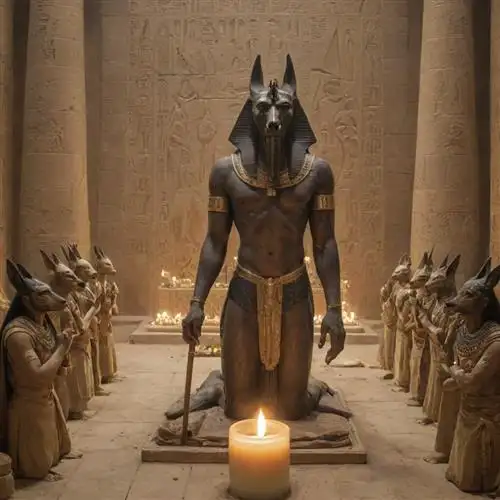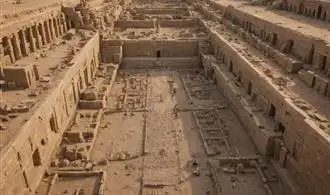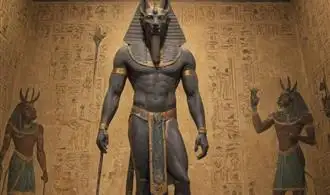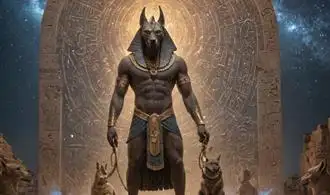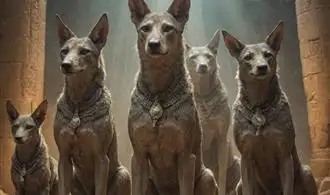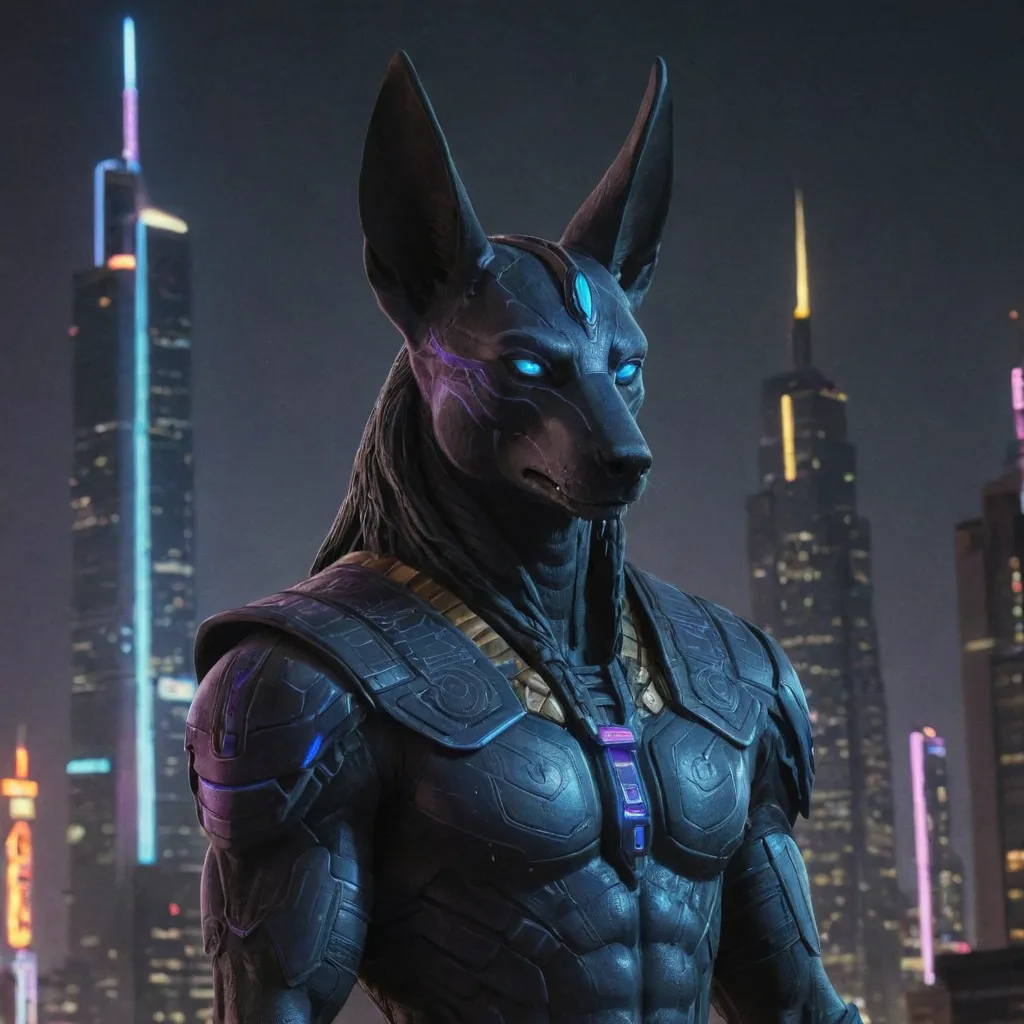
The Jackal-Headed God Anubis
The Jackal-Headed God Anubis is a captivating figure in ancient Egyptian mythology, shrouded in mystery and symbolism. Anubis was a crucial deity in the Egyptian pantheon, responsible for guiding the dead through the underworld and overseeing the process of mummification. Beyond his widely known role, Anubis held a deeper, more intricate significance that is often overlooked.
At the core of Anubis' identity was his connection to the afterlife and the transition from life to death. As the god of embalming and funerary rites, Anubis played a vital role in the preservation of the deceased, ensuring a smooth journey to the afterlife. His jackal-like appearance, with its keen senses and ability to navigate the darkness, made him the perfect guide for the dead, leading them through the treacherous paths of the underworld.
But Anubis' significance extended far beyond his role as a funerary deity. He was also associated with the protection of the dead, ensuring the safety and well-being of the deceased in the afterlife. This protective aspect of Anubis was often symbolized by his presence at the foot of the funerary couch, guarding the body and the soul's transition.
Anubis' iconography is also rich in symbolism and hidden meanings. His depiction as a jackal-headed figure is believed to represent his connection to the natural world, as jackals were known to frequent cemeteries and were associated with the transition between life and death. Furthermore, the black color of Anubis' skin was symbolic of the color of mummified flesh, alluding to his role in the embalming process.
In addition to his funerary and protective responsibilities, Anubis was also believed to possess divination and oracular abilities. Predict the Future with This Guide to Anubis Iconography explores the intricate symbolism and rituals associated with Anubis' iconography, which were often used to divine the future and uncover hidden knowledge.
The Sacred Role of Anubis in Egyptian Mythology
Anubis, the enigmatic jackal-headed deity, held a sacred and pivotal role in the intricate tapestry of Egyptian mythology. As the guardian of the dead and the embalming process, Anubis was revered as a crucial figure in the journey of the departed from this life to the afterlife. His importance transcended the confines of funerary rituals, as he was also closely associated with the concept of transformation and the cyclical nature of existence.
At the heart of Anubis' significance lies his intimate connection with the embalming process. As the patron of embalmers and the protector of the deceased, Anubis oversaw the meticulous preparation of the body, ensuring the safe passage of the individual's spirit to the afterlife. This responsibility was not merely a practical one but also imbued with profound metaphysical meaning, as the embalming ritual was seen as a symbolic rebirth, a transformative process that allowed the soul to transition to the next phase of existence.
Beyond his role as the guardian of the dead, Anubis was also closely associated with the concept of judgment and the weighing of the heart. In the famous "Weighing of the Heart" ritual, Anubis would preside over the weighing of the deceased's heart against the feather of Ma'at, the goddess of truth and justice. This solemn ceremony determined the fate of the individual's soul, with a heart that outweighed the feather signifying a life well-lived, while a heavier heart indicated a soul unworthy of the afterlife.
Interestingly, Anubis' pivotal role in Egyptian mythology was not limited to the realm of the dead. Discover the Surprising Insights of the Anubis Deity as he was also believed to be a guardian of the living, protecting individuals from the dangers and uncertainties that permeated the mortal realm. This dual aspect of Anubis, as both a guide for the dead and a protector of the living, underscores the inherent complexity and multifaceted nature of this ancient deity.
The Iconography and Symbolism of Anubis
Anubis, the ancient Egyptian god of the afterlife, is a figure steeped in rich symbolism and iconography. This jackal-headed deity played a crucial role in the complex funerary rituals and beliefs of the ancient Egyptians. Understanding the visual representations and symbolic meaning of Anubis provides a deeper insight into the significance of this enigmatic god.
The jackal-headed form of Anubis is perhaps the most recognizable aspect of his iconography. This unique appearance is believed to be based on the Egyptian desert jackal, a scavenger animal closely associated with the necropolis and the world of the dead. The jackal's keen senses and ability to navigate the realm between the living and the dead made it an apt choice to represent Anubis, the guide and protector of the deceased.
In addition to the jackal head, Anubis is often depicted holding various objects that symbolize his roles and responsibilities. These include:
- The ankh, the symbol of life, representing Anubis' role in facilitating the transition to the afterlife.
- The was scepter, a symbol of power and dominion, reflecting Anubis' authority over the funerary rites and the realm of the dead.
- The flail, a symbol of kingship and authority, further emphasizing Anubis' status as a powerful deity.
The color palette associated with Anubis is also rich in symbolism. The god is frequently depicted in black, a color that represents both death and the fertile soil of the Nile Valley, which was essential for sustaining life. This duality reflects Anubis' role as a deity who presided over the cycle of life, death, and rebirth.
Another significant aspect of Anubis' iconography is his association with the embalming process. In many funerary scenes, Anubis is shown performing the crucial rituals of mummification, ensuring the preservation of the deceased's body and their successful journey to the afterlife. This role as the overseer of the embalming process cemented Anubis' status as a pivotal figure in the Egyptian funerary rites.
The Influence of Anubis in Ancient Egyptian Rituals and Beliefs
Anubis, the jackal-headed god, held a central role in the ancient Egyptian pantheon, his influence permeating the rituals and beliefs that shaped the civilization. As the god of the dead, embalming, and the afterlife, Anubis was instrumental in guiding the deceased through the treacherous journey to the afterlife.
One of the primary functions of Anubis was the mummification process. Deemed the "Lord of the Sacred Land," Anubis oversaw the intricate and sacred rituals of embalming, ensuring the preservation of the physical body for the soul's journey. Embalmers would invoke Anubis's name and seek his divine guidance during the mummification rites, believing that his presence would guarantee the success of the process.
Anubis's role extended beyond the physical realm, as he was also responsible for guiding the souls of the deceased through the afterlife. In the ritual of the "Weighing of the Heart," Anubis would oversee the judgment of the dead, placing the heart of the deceased on a scale and weighing it against the feather of Ma'at, the goddess of truth and justice. If the heart was found to be pure and free of sin, the soul would be granted passage to the afterlife. Anubis's presence and guidance were crucial in this pivotal moment, ensuring the safe transition of the soul to the next stage of existence.
Moreover, Anubis's influence was evident in various funerary rites and beliefs. The jackal-headed god was often depicted standing guard over the deceased, symbolizing his role as the protector of the dead. Funerary masks and statues of Anubis were placed in tombs, believed to invoke his divine presence and safeguard the departed on their journey to the afterlife.
The cult of Anubis held immense significance in ancient Egyptian society, with temples and shrines dedicated to the god found throughout the land. Worshippers would seek Anubis's favor, offering prayers and offerings in the hope of securing his guidance and protection for their loved ones in the afterlife.
The Enduring Legacy of Anubis in Modern Culture
Anubis, the ancient Egyptian deity associated with mummification and the afterlife, has maintained a strong presence in modern culture. Despite the passage of centuries, this enigmatic figure continues to captivate the imagination of people around the world. From its depiction in popular media to its symbolism in contemporary art and design, the influence of Anubis is far-reaching and multifaceted.
In the realm of popular culture, Anubis has found a prominent place. The character has been featured in numerous films, television shows, and video games, often serving as a representation of the mystical and supernatural elements of ancient Egyptian mythology. This exposure has played a significant role in introducing Anubis to a wider audience, sparking a renewed interest in the god's significance and symbolism.
Beyond the realm of entertainment, Anubis has also found a place in the world of art and design. The distinct iconography of the jackal-headed deity has been reinterpreted and incorporated into various artistic mediums, from tattoo designs to fashion accessories. This visual representation of Anubis serves as a testament to the enduring power of ancient symbols and their ability to resonate with modern sensibilities.
Interestingly, the influence of Anubis extends beyond the purely aesthetic realm. In the realm of spirituality and esoteric practices, the figure of Anubis has found new relevance. Some contemporary practitioners of ancient Egyptian-inspired spiritual traditions have incorporated Anubis into their rituals and beliefs, viewing the deity as a guide and protector in the journey through the afterlife.



